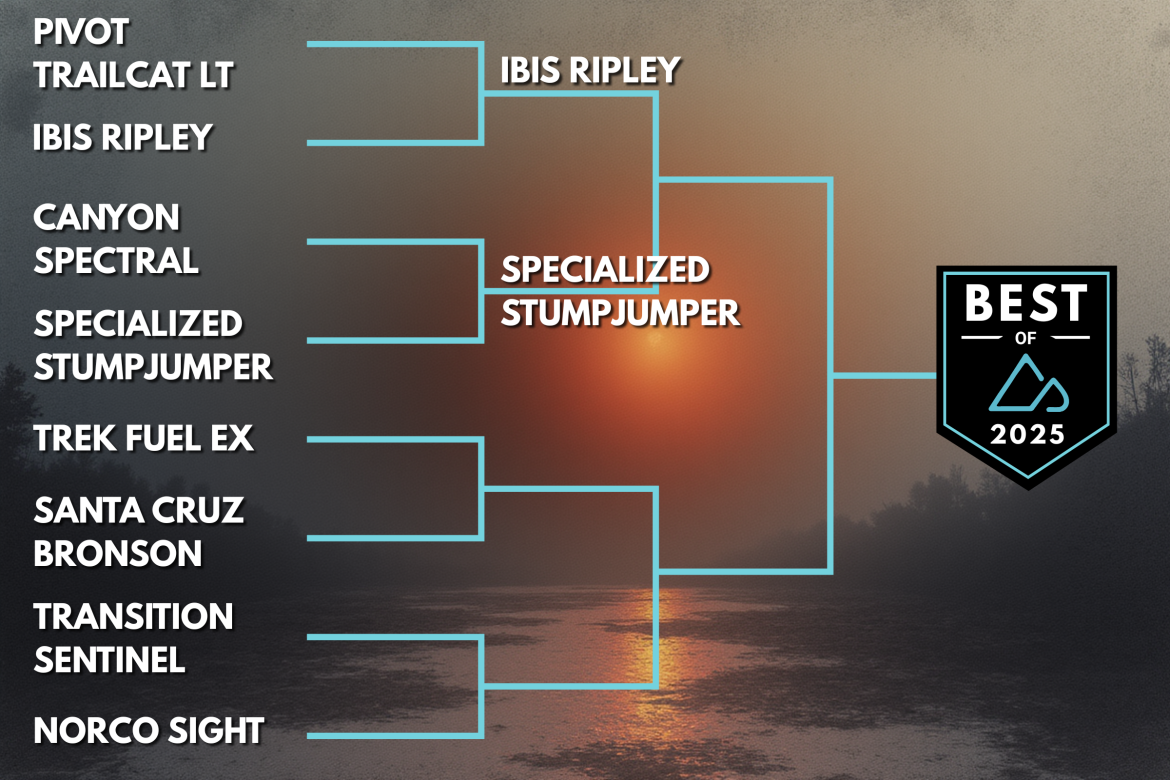
The first round of the 2025 Trail Bike of the Year Tournament just wrapped up, and the competition was fierce! As we’ve seen, the latest trail bikes feature surprisingly similar specs, so it’s the details that really count. The first semifinal matchup — between California brands Specialized and Ibis — pits a 50-year-old industry colossus against a much smaller brand, though one that’s actually been around for 44 years.
But first, a recap of the round one competition that brought us here.
The Specialized Stumpjumper 15 EVO comes out strong
It was the Canyon Spectral versus the Specialized Stumpjumper 15 EVO, two bikes with very similar geometry across several key dimensions. But in the end, the voting wasn’t even close: the Stumpjumper won handily, garnering 62% of Singletracks reader votes.
I suspect suspension design was a deciding factor for many readers. The Stumpjumper 15 EVO offers a bit more squish than the Spectral and features Genie suspension tech, which is a Specialized exclusive. Having ridden a Stumpjumper 15 with Genie, I can confirm that it’s the real deal, and for many who have tested it, the design is a game-changer.
The Stumpjumper frame delivers “six-way geometry adjustment,” giving buyers more options to tweak the fit and feel than the Spectral offers. With long, 445mm chainstays, on paper, the Spectral isn’t quite as playful as the Stumpjumper, which may have swayed readers as well.
The Ibis Ripley squeaks by the Pivot Trailcat
Only 21 votes separated the Ibis Ripley from the Pivot Trailcat in first-round voting, making it the tightest race so far. That’s no surprise: both the Trailcat and Ripley make use of a DW-Link suspension design, and the prices for the builds we compared differed by just $150. Ultimately, the Ripley is moving on to the semifinals, though the Trailcat, a brand-new model introduced just this year, deserves kudos for coming so close.
The differences between the Ripley and Trailcat geometries are stark, and the tight vote shows that there’s no set of magic numbers that buyers are looking for. The Ripley sports a significantly longer reach and longer chainstays than the Trailcat.
A few readers questioned why we chose the Trailcat LT over the Trailcat SL for this comparison. In the end, the Trailcat SL, with 120mm of rear suspension travel, sits too far outside the 130-150mm travel range in this year’s Trail Bike of the Year Tournament. Would the Trailcat SL, with its 140mm front end to match the Ripley, have been victorious? Perhaps. Personally, I think the Trailcat SL has a chance to beat the latest and greatest downcountry bikes, but that’s a tournament for another time.
One area where the Trailcat clearly fell short of the Ripley in the first round is the build kit. Though both bikes include a SRAM GX Eagle Transmission drivetrain, the Ibis delivers premium Fox Factory suspension at a price point that’s also lower than the Pivot. Beyond the builds being compared, the Ripley is available in a more affordable aluminum frame option, which the Trailcat is not.

Cage match: Ibis Ripley vs. Specialized Stumpjumper 15 EVO
Today, it’s the battle of more suspension travel versus less. The big versus the little guy. Electronic versus mechanical.
There are big differences between the Ibis Ripley and the Specialized Stumpjumper 15 EVO, so much so that this could make for an awkward matchup. Still, these trail bike builds are priced exactly the same, feature similar geo numbers, and both bikes are offered in carbon and aluminum.
| Specialized Stumpjumper 15 EVO Comp | Ibis Ripley v5 Deore | |
|---|---|---|
| Suspension travel front/rear | 160/145mm | 140/130mm |
| Drivetrain | SRAM S-1000 Eagle AXS Transmission (electronic) | Shimano Deore (mechanical) |
| Suspension | Fox Float 36 Rhythm fork, Fox Float X Performance with Specialized GENIE shock | Fox Factory Float SL 36 fork, Fox Factory Float w/EVOL shock |
| Geometry (size large* frame) | HTA: 64° STA: 76.5° Reach: 500mm Chainstay: 437mm | HTA: 64.9° STA: 77.4° Reach: 511mm Chainstay: 440mm |
| Frame weight | 6.4lb** | 7.3lb*** |
| Price | $4,999 | $4,999 |

Suspension
Is 130mm of rear suspension travel enough for a trail bike? Is a 160mm fork too much? Obviously, it depends on who you’re asking. This matchup potentially answers that question, at least among you, the esteemed readers of Singletracks.
The Specialized Stumpjumper 15 was released in 2024 with a significant 15mm rear suspension bump compared to the previous version. Then, just a year later, the fork travel bounced up from 150mm to 160mm, which brought the Stumpy from a 140/130mm trail bike (like today’s Ripley) to a 160/145mm bike in the span of two short years. If anything, this competition might become a referendum on whether trail bikes really need more travel, or if they are capable enough already.
Travel lengths notwithstanding, the Ripley and Stumpjumper both utilize four-bar suspension designs. The DW-Link Ibis uses has been proven over many years, as has the Specialized FSR design now paired with fresh Genie suspension tech. Each design has its fan base, and both perform exceptionally well on the trail.
The Ibis Ripley is coil-shock compatible. The Stumpy is too, though running a coil would mean swapping out the Genie shock that ships with the Comp build. Specialized says Genie offers “the best of both worlds — coil and air — with extra tuneability,” and though a couple Stumpjumper 15 builds came with a coil, none of the current generation Stumpjumper 15 EVO builds have one. None of the Ripley builds come with a coil either, so buyers will need to purchase one separately.
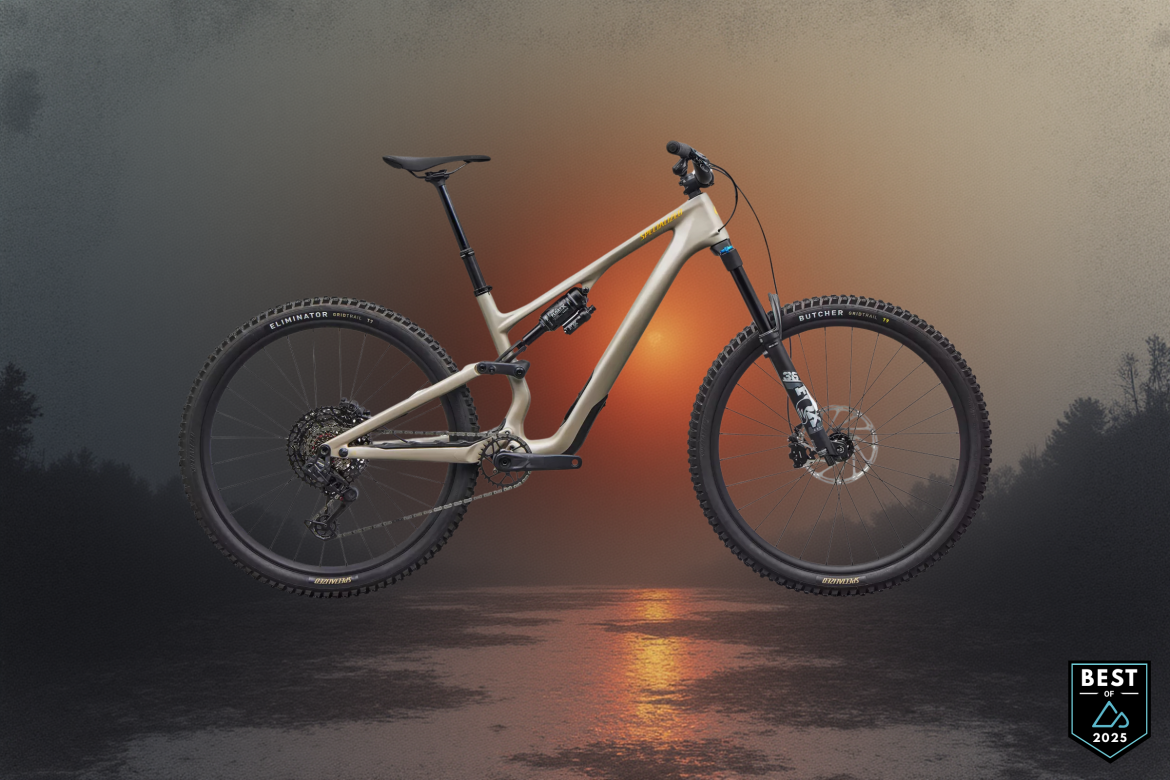
Frame features and build kit
Both the Ibis Ripley and Specialized Stumpjumper feature in-frame storage, and each is available in a carbon or aluminum frame, giving buyers plenty of options and price points to choose from.
The Ripley has a flip chip that allows buyers to convert the 29er bike to mixed wheel without affecting the geometry. There’s a set of bottle mounts inside the front triangle, though bottle sizes are limited on the smaller frames, and the Ripley doesn’t feature accessory mounts.
Buyers get more adjustability with the Stumpjumper 15 EVO, which offers six-way geometry adjustment to tweak the bike’s fit and ride feel. Like the Ripley, the Stumpjumper can run mixed wheels and features bottle mounts inside the front triangle, but no accessory mounts.
Ibis and Specialized price their framesets the same, $3,599 for the Ripley and Stumpjumper. Almost a pound separates the weight of the two, with the Stumpjumper weighing less at 6.4lb.
Though these trail bike matchups are mainly focused on frame specs, we can’t help but compare similarly priced builds. Though the Ripley Deore and Stumpjumper Comp are priced identically, Ripley buyers get a mechanical drivetrain and top-shelf Fox suspension. Stumpjumper buyers, on the other hand, get electronic shifting paired with Performance-level suspension. Depending on buyers’ priorities, one of these builds will certainly be more compelling than the other.
Geometry
As you can see from the geometry numbers above, the Stumpjumper and Ripley are very similar. So similar that I won’t try to pick them apart and say one bike is more playful, or better at climbing, than the other, for example. For all intents and purposes, most riders won’t be able to tell the two apart based on the geometry.
However, when it comes to fitting a wide range of rider sizes, the Stumpjumper is notably offered in six sizes compared to five from Ibis. Both claim to fit a similar rider height range, from about 5′ to 6’6″. Ibis fits slightly taller riders, up to 6’7″, on the largest Ripley, while Specialized says their S1 Stumpy should work for riders down to 4’11”. With six sizes available, the Stumpjumper sees smaller geo bumps between sizes, which means buyers are more likely to find a good fit.
Though the reach on the Specialized size S5 and Ibis size large frames compared here are within 11mm of one another, looking at the range of reaches, it’s clear the Ripley sits in the longer-is-better camp at the moment. The smallest frames have 440mm of reach compared to just 400mm for the smallest Stumpjumpers, and the largest Ibis frames stretch all the way to 545mm compared to 525mm for Specialized.
Which trail bike reigns supreme?
The semifinal matchup between the Ibis Ripley and Specialized Stumpjumper 15 EVO presents a compelling clash of philosophies in modern trail bike design. While both California brands offer similarly priced builds ($4,999) with comparable geometry, the differences lie in the details. The Stumpjumper delivers more suspension travel (160/145mm vs. 140/130mm), a lighter frame (6.4lb vs. 7.3lb), electronic shifting, and six-way geometry adjustment across six frame sizes.
Meanwhile, the Ripley counters with premium Fox Factory suspension and a proven DW-Link design. This matchup essentially asks riders to weigh their priorities: Do you want the extra cushion and adjustability of more travel and geometry options, or do you prefer a nimble setup with top-tier suspension components? The competition also serves as a referendum on long reaches, and whether modern trail bikes truly need the extra travel that brands like Specialized are pushing, or if the traditional 130-140mm range remains the sweet spot for all-around trail riding.
The final Trail Bike of the Year matchup will be revealed on December 2, 2025.











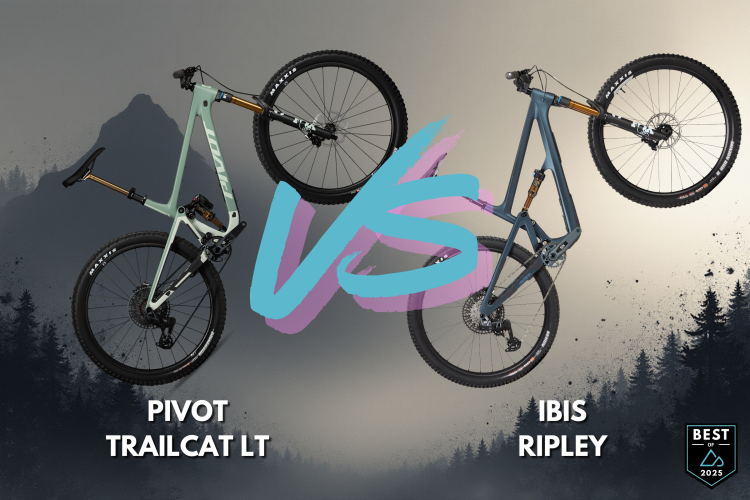
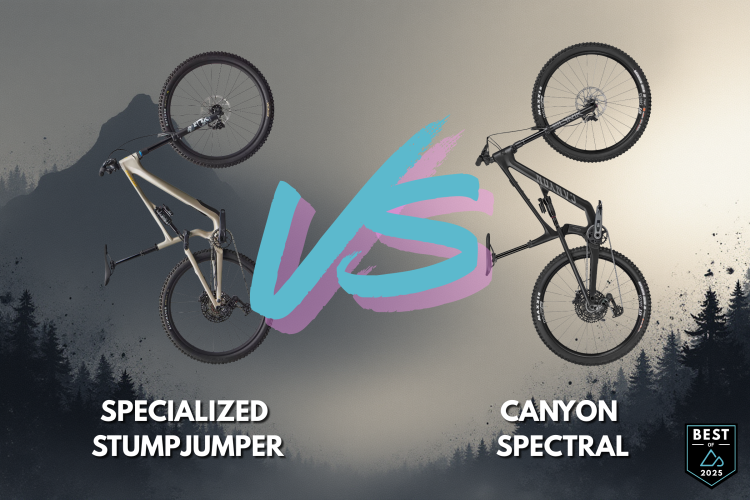


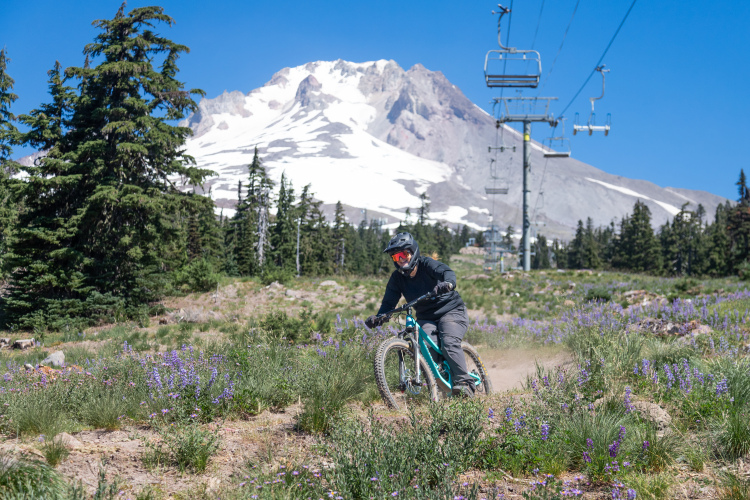




0 Comments